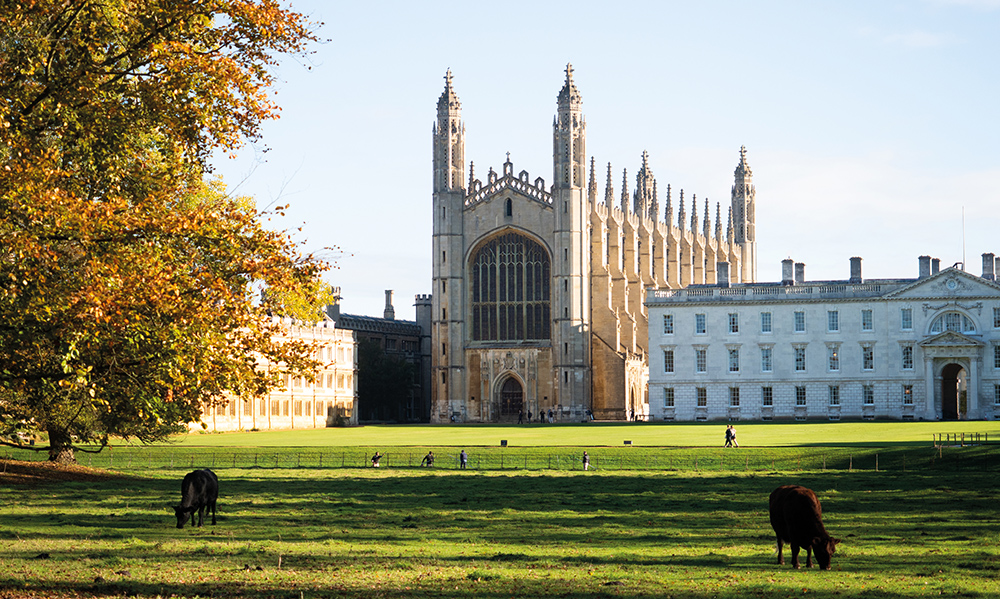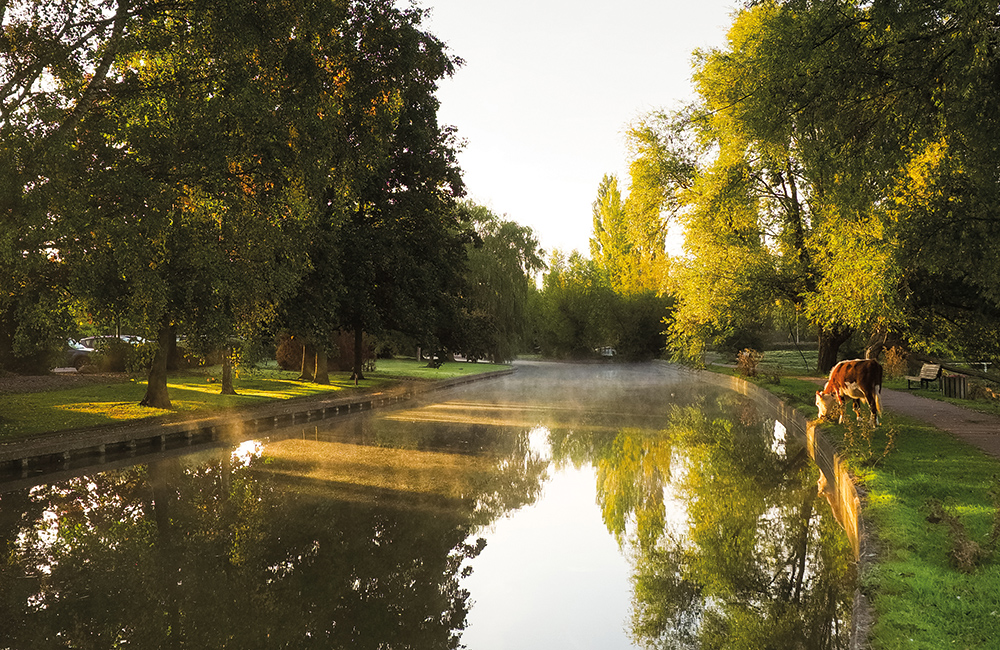Images: Claire Voyle
You can’t have missed the cows strolling through our city’s green spaces. Charlotte Griffiths meets Cambridge’s most famous four-legged residents
Cambridge is undeniably a city with green space at its heart. The Botanic Gardens cover 40 acres, Parker’s Piece a further 25, and visitors often remark on the beauty of the college gardens, carefully tended to provide displays of seasonal colour that break up the urban sprawl. Yet it’s the narrow slivers of wild common land reaching right into the heart of Cambridge that provide the strongest sense of our Fenland setting – in part, the reason our city looks the way it does today is thanks to generations of farmers who’ve chosen to exercise their right to graze livestock on those common spaces.
Just 3{b486c5a37ab2d325d17e17d701cb2567b1ecd1814e8ceb33effa2a4f1f171d46} of land in England is registered as commons: the majority lies in the north of the country, but small pockets can be found dotted across the landscape, with several right in the heart of our city. This isn’t public land, but rather spaces that are owned by the Council, the Colleges or corporations, and on which we – as residents and landowners – can exercise several ancient rights, including one to pasture: to graze and keep specified animals without needing land of our own.
The Commons Registration Act 1965 gives evocative descriptions of our city’s grazing grounds. Laundress Green, the small parcel of land at the end of Silver Street where the colleges’ washing used to be done, and that now welcomes the majority of our city in the summer months for picnics and drinks on balmy evenings, is described as being able to hold “a total of two beasts… all the year on Sundays, Wednesdays and Fridays from sunset to sunrise”, while Empty Common, a sliver of land stretching off Brooklands Avenue – now home to a thriving and beautiful community garden – could host up to five “mares, geldings and cows”.
“Empty Common could host up to five ‘mares, geldings and cows’”
In 1985, the Cambridge City Council Act revised the council’s rights to determine where, when and how many animals were grazed: the current application form for those looking to raise livestock within the city gives the options of Coe Fen, Coldham’s Common, Midsummer Common, Sheep’s Green, and Stourbridge Common. The council also employs a dedicated ‘pinder’ (or ‘pindar), an individual who, historically, would ‘pin’ loose cattle in place, and now keeps a watchful eye on our city’s bovine residents. The ‘armadillo’ public restrooms on Midsummer Common, designed by local architects Freeland Rees Roberts, even had to include a dedicated storeroom for the pinder, where they can keep cattle feed and necessary equipment.
Several individual farmers now make use of the pinder’s services and exercise their grazing rights, paying £60.98 per animal or £38.44 per animal for herds of ten or more – and that’s why you’ll spot a variety of different breeds as you make your way across the city.
One of the farmers is Angelika von Heimendahl, local veterinary surgeon and owner of around 65 Red Poll cattle, which you’ll normally be able to find grazing on Grantchester Meadows and across Midsummer Common. “Red Poll are the local breed,” she explains. “They’re from East Anglia, they grow well on grass, and they have a good temperament – plus they’re also a little smaller compared to other breeds. When you have that many people encountering the cattle, and cyclists and so on, smaller is probably not a bad idea.”

The winter months see the cows turned out of the common land (Angelika’s are currently in what she laughingly refers to as “bed and breakfast” near Royston) not because it’s too cold, but because the cows would swiftly turn any field to mud in wintery conditions. They’ll return to Cambridge’s green spaces on 1 April, all set to eat their fill until the commons close up again on 1 November, just a few days before the city’s annual bonfire.
“We have a big group of cattle on Grantchester Meadows, and we keep our older cattle on Midsummer Common and then replenish from Grantchester. Two or three go every month for the farmers’ market – they’re between 27 months and 30 months old. People say, ‘do you not get attached to them – do you find it hard when they go?’ And I say no, it’s strange – you get to the stage where you feel they’re ready. I see them as a herd: I love going to count them, and look at them, but I don’t get attached to individuals.”
Having wanted to keep cattle her whole life but lacking the land on which to do so, Angelika was finally inspired by the lull in common grazing in Cambridge following 2001’s outbreak of foot and mouth disease.
“I was talking to someone from the Friends of Midsummer Common who mentioned that they didn’t have livestock on the common at the time, and that it was starting to lose its character as a meadow – and I remember thinking that I should do something.”
“Such a visible collide between rural and urban ways of life’”
Increased regulation following 2001 means keeping cattle is not a wise career path for disorganised individuals. “Each head of cattle now has a passport, two eartag numbers, and you have to register movement within two days, you’re constantly inspected… the amount of attention is amazing. A calf has to be registered with British Cattle Movement within four weeks; a human baby gets six weeks. Basically, if you’re ever lonely, buy yourself a cow…” she laughs.
Dry-aged for three weeks before arriving at the markets, the beef from CamCattle’s Red Poll is marbled, but doesn’t carry much fat on the outside, meaning the meat makes an excellent all-rounder that offers something for every type of cook. “We have quite a few continental European customers on the market who ask for different cuts, and our butcher loves that,” Angelika says. “Some people really like steaks, some people prefer slow cooking, others like roast beef, some like brisket – maybe it’s down to your temperament. I like topside: proper roast beef, pink in the middle with horseradish and gravy.”
There are a few other cities around the UK with such a visible collide between rural and urban ways of life, but not many, and the fact that – thanks to Angelika’s CamCattle – you can cycle past Cambridge’s cows and then just a few minutes later buy the same herd’s beef from the market, is an aspect of life in our city that is deeply cherished by a growing number of food enthusiasts. “There’s a certain part of the population who make an extra effort to source their food and support the farmers whose methods they approve of, and that is a very powerful tool,” Angelika says. “In Cambridge, people can see the cattle and know where their food comes from, they can see they’ve had a good life. Fifty years ago, or 100 years ago, this visibility in the food chain was completely normal – but it’s just all so separate these days. Sometimes consumers underestimate how much they can shape a system. We have an incredible community – particularly on a Sunday at the local produce market, where people get up, get on their bikes and come. I have a lot of respect for them.”
LEARN MORE
The cows of Cambridge have their own Twitter account, sharing images taken by those encountering the cattle. Follow them at twitter.com/cambridgecow
To learn more about CamCattle, visit the CamCattle and CamLamb Facebook page, where you can follow their news and keep up to date with the goings-on of both the business and the herd. You can also find CamCattle at Cambridge central market every weekend, plus at markets in Impington, Fowlmere and St Ives, as well as a market in London’s Hampstead.

